How Your Company Can Get an Innovation Boost Over Breakfast
On the 5th of June, Polish business leaders and IT specialists searching for the most efficient ways to improve business-critical processes through automation got the chance to find the solution — the Camunda process orchestration platform. It was presented at the Camunda Breakfast event arranged in Warsaw by the IBA Group, one of the largest IT service providers in Central and Eastern Europe and Camunda Gold Partner Certified in CEE. The hybrid event, which allowed attendees to engage virtually via YouTube and LinkedIn, attracted over 100 participants, bringing together process automation experts and business/tech leaders interested in gaining valuable insights into process optimization and efficiency enhancement offered by Camunda BPM.
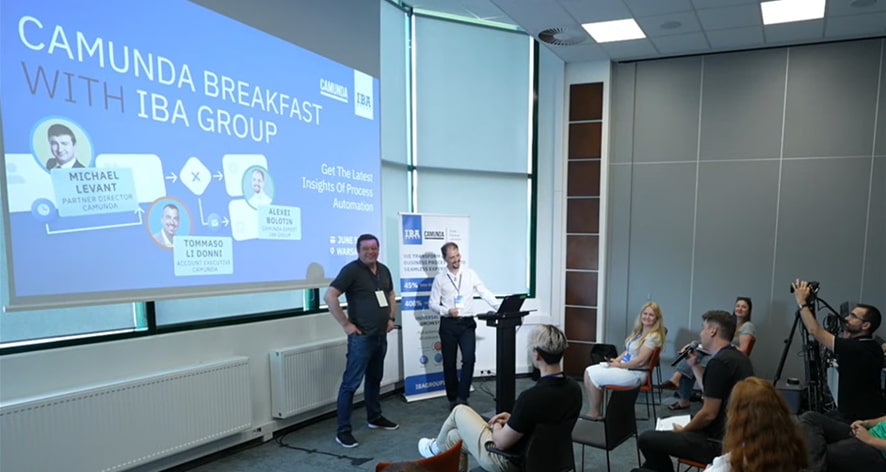
A Glimpse into the Agenda: From Common Challenges to Specific Case Studies
Over roughly four hours, the participants engaged in five presentations followed by Q&A sessions moderated by Alex Burak, the IT Solutions Consultant from the IBA Group, who also welcomed the audience on behalf of the organizer. Tommaso Li Donni, the Regional Account Executive of Camunda, spoke about today’s challenges for business process automation, and he discussed how the process orchestration provided by the platform addresses these issues. Michael Levant, the Camunda Regional Partner Director, shared some takeaways from the record-breaking CamundaCon Berlin 2024, which took place in the middle of May.
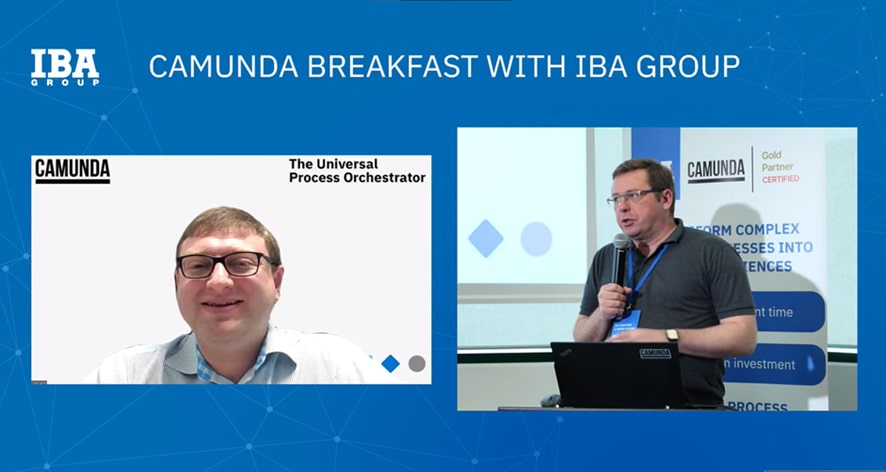
Alexei Bolotin, the IBA Senior Project Manager and Camunda Lead Expert, highlighted the benefits of the cloud-native Camunda 8 and explored the best practices for migration from Camunda 7. During his second session, he detailed the crucial role of the connectors available for users of Camunda 8, and he illustrated how the EasyRPA Connector developed by the IBA Group seamlessly integrates robotics process automation into workflows designed and executed on Camunda. Maria Alish, Camunda Service Manager and Business Analyst at the IBA Group, proved the efficiency and easy implementation of EasyRPA Connector by presenting an onboarding process case study with a live demo and KPIs resulting from the project “Revolutionizing Employee Onboarding”, implemented by IBA Group .
The event also served as a platform for fruitful networking, as the participants had a great opportunity to get acquainted, communicate, share ideas, and build promising connections during registration and the 30-minute coffee break, encouraged by representatives of the organizer.
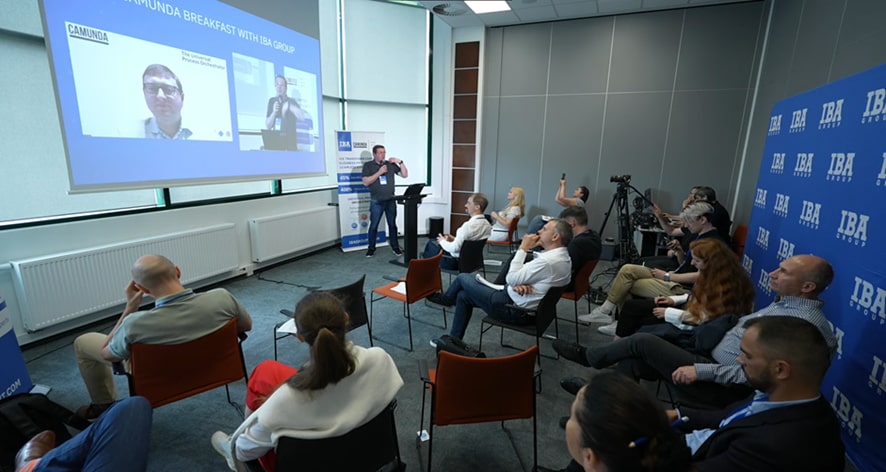
Camunda Busts the Myth of a Value Trap Created by Automation
How can a business derive even more value than predicted from the technology it implements? By shifting from siloed automation to end-to-end process orchestration with Camunda.
In his presentation, Tommaso Li Donni emphasized that digitalization led to a dramatic increase in customer expectations as to the quality of digital interactions with businesses. According to statistics, most customers are ready to abandon a company after just two or three negative interactions. This creates pressure urging organizations to digitalize their processes and adopt new technologies like AI or RPA to stay competitive in the market.
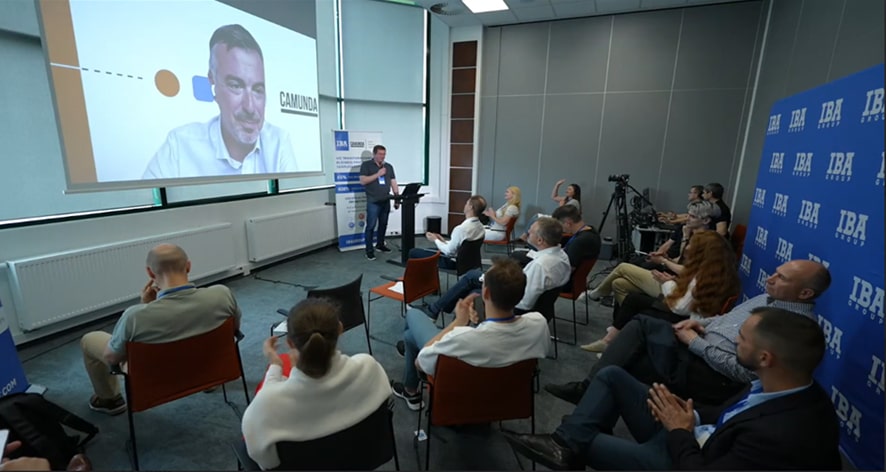
However, as organizations prefer to invest in quick point solutions, automating separate parts of the customer journey, the race for tech innovation translates into technical debt accumulation and a disjointed customer experience. The siloed automation makes it difficult for tech teams to integrate, maintain, upgrade, and harmonize point solutions within the IT infrastructure and, as a result, to deliver the efficiency that meets the company’s needs and customer expectations. “This means effectively that businesses and their IT departments these days are almost talking different languages,” said Tommaso Li Donni.
While siloed automation actually results in reduced time to market and poor visibility into ROI, process orchestration allows organizations to maximize the value of their investments. Not only does it connect point solutions, people, devices, legacy systems, and popular modern business tools, but it also tames process complexity, scales efficiencies, and aligns business and tech stakeholders.
To ensure true end-to-end process orchestration, Camunda uses BPMN and DMN standards, the cloud-native Zeebe engine, an extremely flexible architecture, and advanced workflow patterns. The speaker described their approach as “the business coming up with requirements and working with IT to have these requirements mapped, implemented, and run by Camunda in a way that creates a lot of collaboration and know-how sharing between the two critical departments.”
Since the platform connects all types of endpoints across an end-to-end process, it accumulates comprehensive information, which helps it better utilize AI technology. “As a process orchestrator, Camunda definitely has a unique position for what is now being seen as the key application: artificial intelligence use cases,” said Tommaso Li Donni. Camunda ensures high data quality by providing access to fully documented processes and both input and output data from all affected endpoints, including tasks that require human intervention.

The speaker emphasized that together with solutions from their partners, Camunda provides a full hyper-automation tech stack covering process mining, process modeling, process orchestration, and process intelligence. While the platform has business intelligence, low-code integration, and decision automation embedded into it, partner solutions offer vast opportunities for process mining, intelligent document processing, robotic process automation, and AI and microservices implementation.
Tommaso Li Donni also highlighted their aspiration “to provide an integrated yet flexible universal automation platform with embedded intelligence,” mentioning that the analytics part of it helps organizations to further improve their workflows and gain even more value from automation.
During the Q&A session, the speaker acknowledged the importance of working closely with Camunda’s partners, existing and potential customers, and experts from various industries to help their clients spot prospective Camunda use cases and see business value in process orchestration before making an investment. He confirmed that not only big enterprises but also SMBs can benefit from using the platform since it can alleviate a lot of day-to-day challenges. He recommended starting automation with Camunda from customer interaction and workflows in high need of digitalization, where value can be seen immediately.
When asked about the Camunda connector marketplace, the speaker said: “Connectors are fundamental for the platform to be as efficient as it can be when onboarding our clients.” Answering the question about the use of Camunda in heavily regulated industries, such as finance, telecom, and pharma, Tommaso Li Donni drew an analogy between introducing changes required by regulatory authorities into Camunda-orchestrated processes and replacing car parts, emphasizing how easily it can be done. He also confirmed that by November, their team will be fully up to date on all the possibilities in Camunda 8 that were previously available in Camunda 7.
Camunda 8: How to migrate easily
As everything goes into the cloud nowadays, Camunda must provide businesses with a cloud solution that incorporates all the latest technology. This evolved into a flagship product known as Camunda 8.
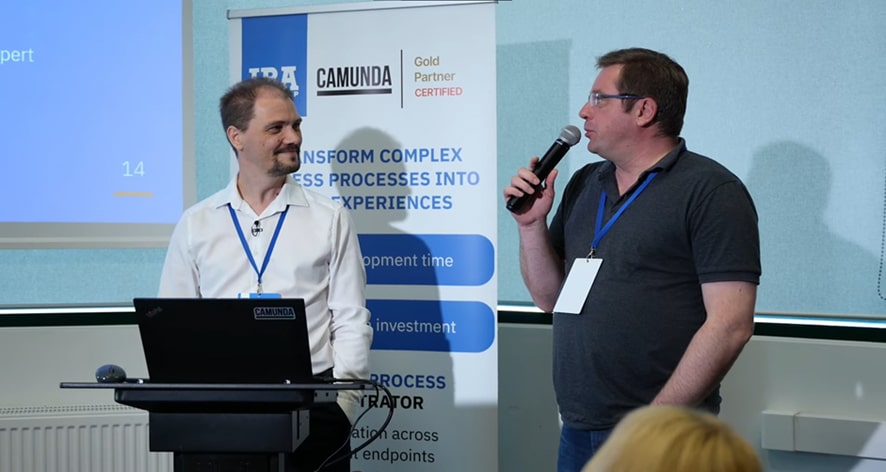
Upon giving a quick overview of Camunda’s evolution and paying tribute to Camunda 7, Alexei Bolotin, the IBA Camunda Lead Expert, highlighted the main features of version 8:
- offers SaaS and Self-Managed options, letting companies choose whether they want to host and manage Camunda themselves or hand over the technical setup to the Camunda team;
- has the Optimize module available out-of-the-box in the SaaS edition, which can be used immediately without any deployment hassle;
- is fueled by a new, more powerful engine developed with a cloud-native and microservice-oriented architecture from the ground up, with all the inherent scalability and security;
- supports polyglot architecture, allowing developers to choose the most suitable tech stack for their implementations;
- replaces Java Unified Expression Language with Friendly Enough Expression Language, which is easier for non-technical users to work with;
- provides multi-tenancy for the Self-Managed option for different teams to separate their data and modules within one cluster;
- introduces a web modeler as part of the platform, making models easily accessible for collaboration between remote teams, business people, and on-site developers and improving the user experience with its very familiar web-based environment;
- incorporates the latest technology, such as containerization, Kubernetes, Elasticsearch, and other modern tools;
- brings back a Center of Excellence for better guidance, knowledge-sharing, and alignment between decentralized teams;
- delivers a wealth of connectors, facilitating integrations and speeding up entire development cycles.
“Camunda 8 is not just the evolution of Camunda, it’s really more a revolution,” said Alexei Bolotin.
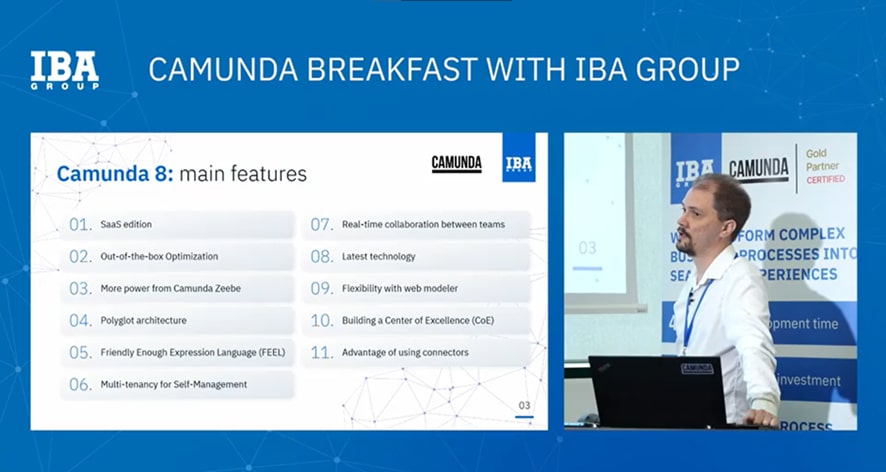
He also summarized the advantages of Camunda 8 for businesses, including:
- faster application development and lower costs thanks to low code features and ready-to-use connectors, eliminating the need for hard coding;
- wider opportunities for AI implementations, starting from simple integrations with external AI tools and ending with ML-ready data sets for business analytics;
- better agility and faster time to value due to the microservice-oriented architecture that allows teams to do their jobs in small tasks and independently.
Alexei Bolotin believes that now is a good time for IT teams to speak with business stakeholders about migration from version 7 and discuss “what Camunda 8 brings to organizations, how it helps us to streamline the processes, and how it helps to save costs and enhance the customer experience.”
The speaker elaborated on a migration methodology provided by Camunda and gave some practical advice:
- start with creating a small proof of concept and arrange a hackathon to familiarize people with the new platform;
- use tools developed by the Camunda community to analyze artifacts and diagrams to better understand the migration impact;
- design a small-scale lighthouse project for Camunda 8;
- opt for Camunda Self-Managed if working in industries with strictly regulated data management;
- upon migrating a project, take the chance to review it for possible improvements.
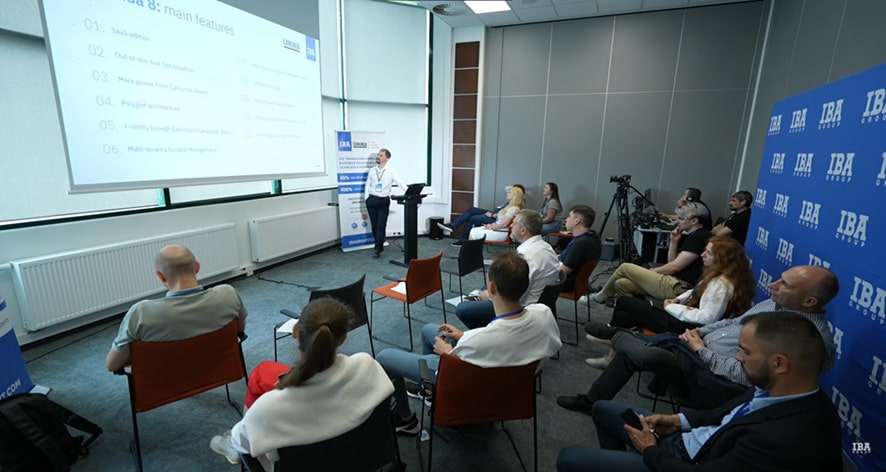
The expert also explained how the Camunda 8 architecture, deployment, and data types differ from the previous version and deciphered how different artifacts and workflow engine data can be affected by the migration. “The main idea for the migration is to let Camunda 8 and Camunda 7 coexist,” said Alexei Bolotin, recommending running parallel versions to take advantage of Camunda 8 while slowly decommissioning Camunda 7. Besides, he emphasized the importance of educating IT teams about Camunda 8 to avoid issues with the migration. He advised reviewing Camunda documentation, using workshops and the knowledge of Camunda Academy, and working with certified Camunda partners, for example, with IBA Group, which is a gold certified partner of Camunda.
As Camunda Lead Expert, Alexei Bolotin took several technical questions and explained how data is passed, stored, and used within the Camunda 8 architecture. He shared his personal experience on the ease of collaboration between IT and business stakeholders on the new platform. “Having the diagrams makes it very easy for developers to understand what they are doing and why they are coding, making their job much more fun,” he said.
Why You Should Visit the Next CamundaCon
If you are into process orchestration and want to get in touch with experts and current PO users who can share their real-life experience, knowledge, best practices, strategies, and tips, CamundCon is definitely the party you should join.
CamundaCon is a bi-annual process orchestration conference held by Camunda in Europe and the USA. It gathers the platform’s users, partners, and clients from both IT and business spheres. The latest event that took place in Berlin was a major success, as it was visited by almost 700 people, alongside over 1,000 virtual participants — the largest number ever. The event lasted for two days and hosted 46 sessions covering technical and business-oriented topics, with speakers and attendees representing many industries.
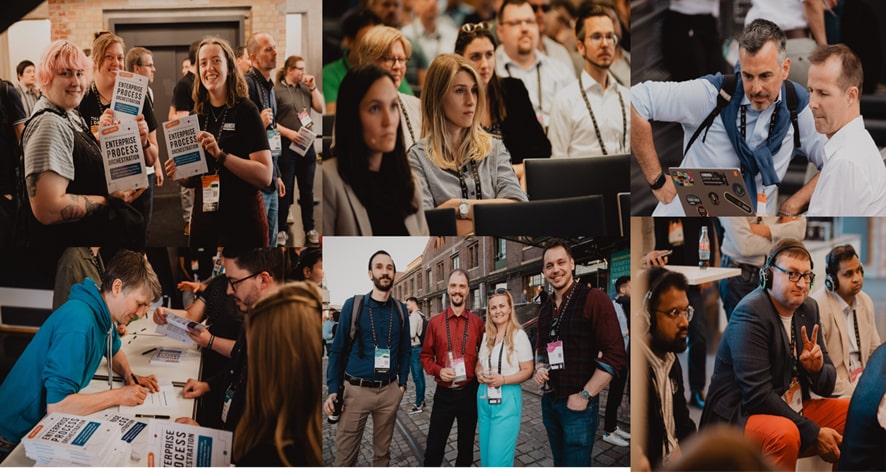
Michael Levant presented one of the numerous stories shared by participants at CamundaCon Berlin— the outcomes of Camunda implementation in ING Lease Polska. The local branch of the leading European leasing and asset finance provider has been using Camunda for about a year, which has allowed them to re-discover and document 37 APIs and introduce 12 reusable connectors. In the presentation, they confirmed that BPMNs helped to reduce cognitive load and engage process owners in the picture, while having a better overview of process execution simplified the life of the IT department and aided business and technology decision-making. They also noted that the connectors facilitated change management processes and made approachable modeling possible. “We talked about the positive things that Camunda provides, but, you know, hearing from a vendor or a partner provides specific flavor, and hearing from a user establishes credibility,” said Michael Levant.

How Camunda Connectors Work Toward Seamless Integrations
Integrations were never easier than with an out-of-the-box connector added to your Modeler drop-down list.
Since most business processes require interaction with systems outside of Camunda to orchestrate human tasks, microservices, IoT, or RPA, Camunda developed the concept of connectors, which are reusable building blocks linking tasks within BPMN processes with external technology. They communicate with third-party systems via APIs and consist of:
- a piece of code that is written in Java to specify how the connector communicates with an endpoint, which is hidden from business users;
- a UI, which serves to visualize the connector’s parameters on business process diagrams, which is hooked in Camunda Modeler.
“What is really important is that a process developer or business analyst who is creating the process actually shouldn’t know about the actual business logic behind how the communication goes on,” said Alexei Bolotin.
The speaker verified that the Camunda 7 Community Edition would get a final release in October 2025, and the Enterprise Edition could be extended to 2030 at the most. “It is the right time to come up with a migration plan, and we have partners and resources, and the IBA Group, of course, which can support you with that,” said Michael Levant.
He also shared the latest update on Camunda 8 Self-Managed licensing, which unlocks the Console and Web Modeler modules for free use and makes the source code of Operate, Tasklist, Optimize, and Identify available. “In October this year, Camunda will become even more open-source than ever,” said the speaker.
Michael Levant invited the Camunda Breakfast attendees to view full CamundaCon Berlin 2024 recordings and submit their own presentations for the next conference scheduled to take place in New York this October. During his Q&A session, he talked about the positive feedback received from the CamundaCon Berlin 2024 participants and the transparency of the event, which encouraged many companies to share even their early-stage projects.

While some connectors are outbound and require only a third-party API to notify the external system about something happening in a process, others are inbound and more complicated due to the different ways of communicating with the endpoints. The speaker singled out three main patterns used in inbound connectors:
- webhooks providing an endpoint on the process side, which can be called by an external system;
- a subscription model similar to Kafka;
- a pooling mechanism based on an endpoint that is called on a regular basis to receive information on any changes.
The Camunda Marketplace offers a wide choice of out-of-the-box connectors that can perform both inbound and outbound communication with different endpoint types, from cloud computing services and automation products to technical protocols and enterprise applications. “By having a big list of connectors out-of-the-box, we are reducing the development time,” said Alexei Bolotin. He also praised the simplicity of building custom connectors with the developer-friendly Connector SDK provided by Camunda, the ease of integration with the Integration Framework, and the open-source approach to connector sharing the platform supports. When answering questions, the speaker revealed that it took 2-3 weeks for their Java developers to create a connector with the SDK and confirmed that the connector was open source and could be easily modified.
Speaking about the Marketplace, the expert emphasized its prominent role in the Camunda ecosystem, as it provides clear guidance and helpful tools to encourage partners and users to contribute to connector development. Users can suggest ideas on lacking connectors to trigger their creation and share their process use cases to help others in connector adoption. Camunda also welcomes developers to certify their connectors to deliver more reliable solutions to users. “The Marketplace is a little bit more than just a collection of the connectors currently available in the market,” said Alexei Bolotin.
To illustrate how connectors work and help in end-to-end process orchestration, IBA Group presented its own connector designed to orchestrate RPA bots created on the EasyRPA platform. The enterprise-level platform launched by IBA Group allows users to build, run, and maintain task automation bots with OCR, ML, and human-in-the-loop possibilities. It also supports containerization, boasts great scalability, and delivers valuable data on the system’s health.
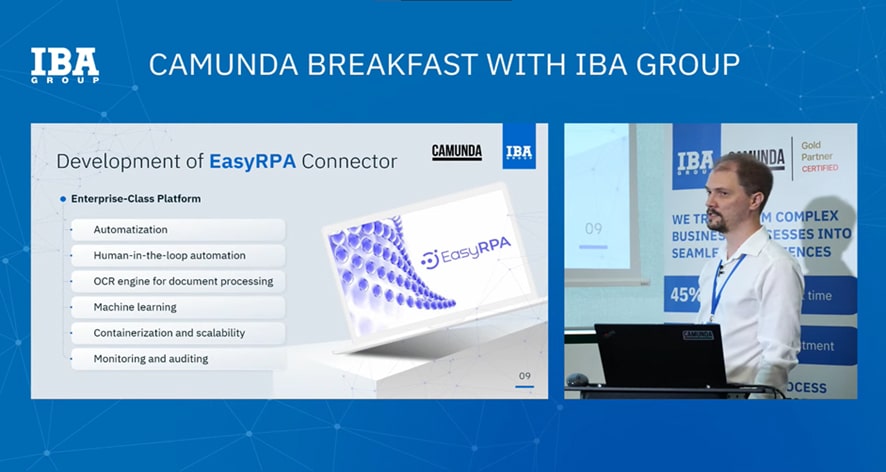
Onboarding Case Study: How Camunda BPM Service Drives Efficiency
With the combined power of Camunda and IBA Group, you can not only respond to global changes promptly but also uncover new opportunities and efficiencies.
Maria Alish, Camunda Service Manager and Business Analyst at the IBA Group, presented a remote, automated onboarding process IBA Group created for an IT company in the gloomy days of COVID-19. In April 2020, the company’s HR department had to promptly switch from their usual onboarding practices built on personal interaction with new hires to automated workflows meeting the physical distancing requirements of that time. Apart from these limitations, IBA Group faced the challenge of a really big, overloaded onboarding process involving many people, various systems, and strict regulations. The complicated process was full of repetitive tasks done manually, which led to an extended onboarding time, and lacked transparency, with the HR staff having little understanding of a new hire advancement through onboarding stages. “On the one hand, the coronavirus brought a lot of negativity to our life, but on the other hand, it opened up many business opportunities,” said Maria Alish.
The EasyRPA Connector is easily accessible in Camunda Modeler via the Change Element drop-down list and is suitable for performing five main operations:
- start Process for initiating RPA;
- get Process Status for defining further actions;
- get Data Store;
- search Item in Data Set ;
- search Item in Data Store to receive data produced during process execution.
According to the speaker, the list is not set in stone since “if you already have your connector, it’s not difficult to extend it with new functionality.” However, even the current functionality allows users to successfully automate repetitive tasks usually performed by humans, recognize and extract data from files, and validate and convert data.
The expert also noted that today, many organizations invest heavily in the digitalization of their processes but do it point by point without having their automated elements joined together. “Here we are coming to hyper-automation, where we want to orchestrate all the IT stuff we currently have,” said Alexei Bolotin. He defined four main steps of hyper-automation — discovery, design, automation, and improvement — and emphasized that Camunda provides tooling for all the stages except discovery.
During the Q&A session, the expert provided practical advice on managing process data when using Camunda and adopting connectors for internal use to reduce development time and ensure alignment between IT teams and departments. He also explained the difference between RPA and BPM, highlighting that “they are not contradictory; they are complementary.”
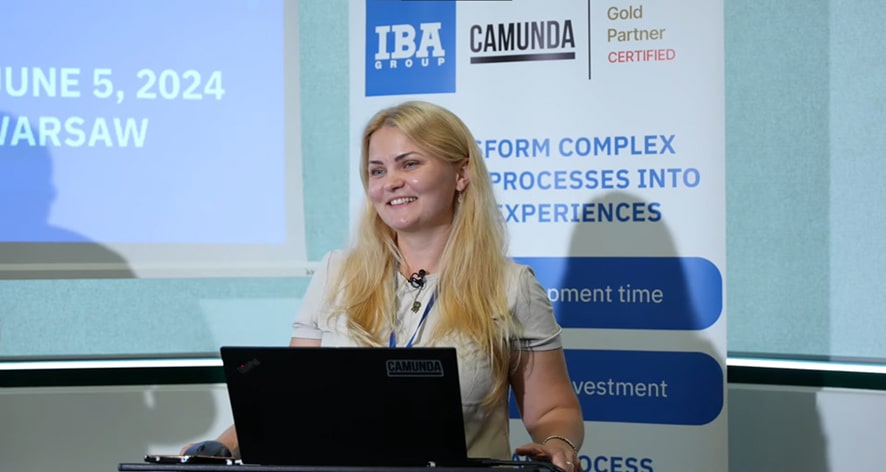
To make the onboarding process more efficient and remote, IBA Group performed a comprehensive analysis of the existing workflows and regulations and came up with a new architecture based on the Camunda platform. It involved a lot of connectors, for example, SendGrid Connector for sending emails and EasyRPA Connector for task automation, multiple application forms, the legacy Lotus Notes collaborative platform adopted in the company, and AI modules. The combination of EasyRPA and AI was introduced to automate human tasks and ensure efficient data recognition, extraction, and validation while Camunda provided convenient centralized process management, simple integration with other systems, and vast possibilities for process monitoring. “We can see the running of the process, and we can understand which candidate is, which step is, who is responsible for this step,” said Maria Alish.
The project implementation resulted in:
- onboarding time reduced from to 4 hours;
- employee Net Promoter Score increased by 8%;
- document reruns cut down by 67%;
- 85% efficient document recognition;
- enhanced company reputation.
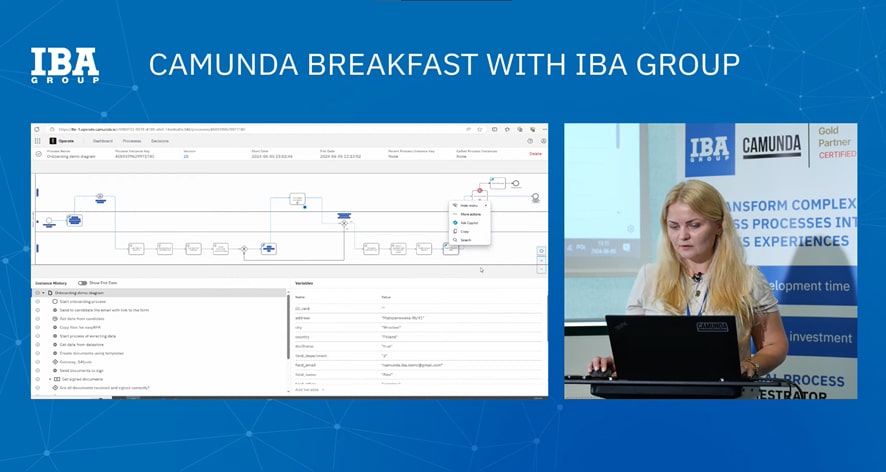
Since sooner or later, it is necessary to upgrade to the platform’s new version, the speaker presented a live demo showing how to use Camunda 8 and its connectors to launch an automated onboarding process. For better understanding the demo was constructed with sample forms and three connectors, namely, Webhook Connector, SendGrid Connector, and EasyRPA Connector, and involved only three endpoints — a candidate, HR, and EasyRPA. The speaker demonstrated how to assign tasks to humans via Tasklist, how properties for EasyRPA Connector are specified in Modeler, and how to observe the process progress in Operate. The demo also showed data extracted by EasyRPA bots from documents received via email, HR forms populated with the extracted data, and databases the bots interact with upon recognising documents and transferring information from them.
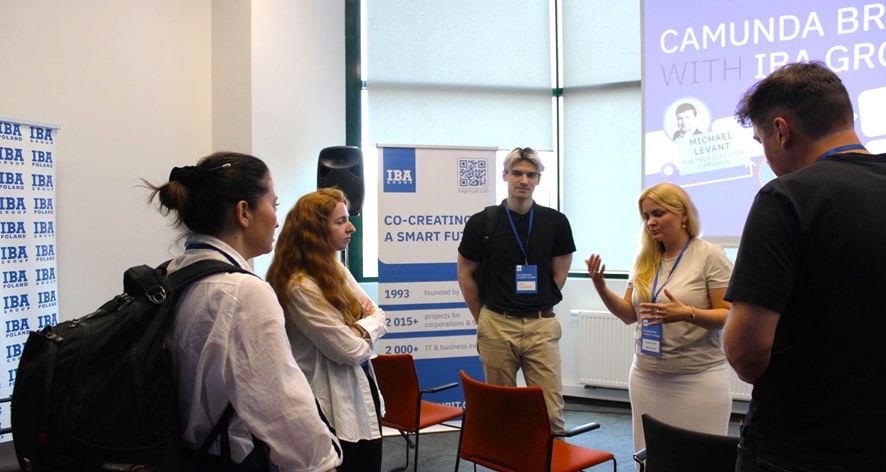
Camunda Breakfast Key Takeaways
Camunda is a robust and flexible platform that can seamlessly integrate, manage, and track a huge number of endpoints within one process, taming workflow complexity. It boasts a vast ecosystem and active community, which allows Camunda, in tandem with partners, to deliver a full hyperautomation tech stack and help its users find areas for further improvements. It lets business and IT speak one language and easily create well-described business processes, thus simplifying automation and reducing time to value.
Based on feedback from participants, they were impressed by the simplicity and flexibility of running the onboarding process on Camunda 8 shown in the demo and found this presentation very helpful and inspiring.

Camunda connectors play a crucial role in end-to-end business process orchestration since they ensure seamless integration with different endpoint types and cut down the development time greatly. EasyRPA Connector is one of the powerful and easy-to-use tools that work toward efficient RPA implementations.
As the Camunda 7 EoL is around the corner, it’s high time to come up with a migration plan, which can be designed and implemented with the help of Camunda partners. “Don’t hesitate to reach out to our partner IBA”, said Michael Levant, emphasizing that the company’s certified engineers have both the expertise and experience required for successful Camunda 7 to Camunda 8 migration.
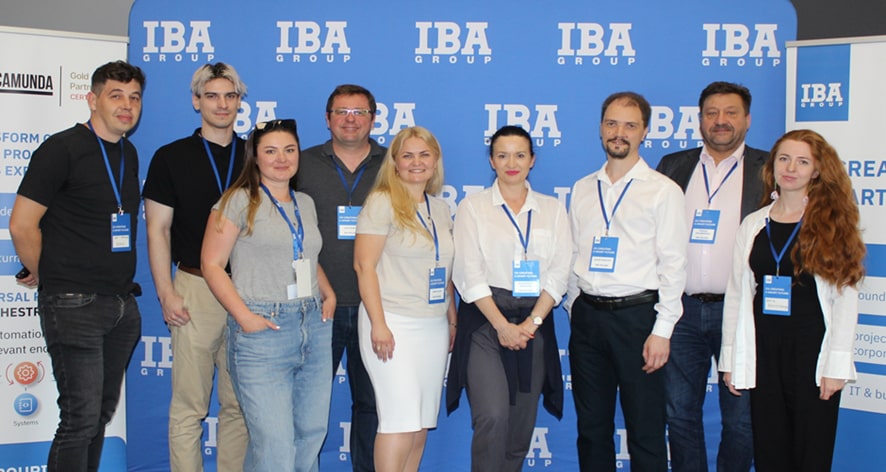
In its turn, the IBA Group team believes that events like CamundCon or Camunda Breakfast are extremely important for IT and business stakeholders interested in effective process orchestration, as they can get direct answers to their specific questions, receive valuable information unavailable on other resources, and build promising professional connections. Namely, Camunda Breakfast made it clear for innovation leads, CEOs, and senior IT managers how they can access innovative, scalable, and integrable solutions to drive corporate growth and efficiency — through the Camunda BPM Service provided by IBA Group.
IBA Group appreciates the contribution made by Camunda representatives, all attendees, and the organizer’s team members to the success of the event and invites existing and potential clients to join our next gatherings. If you are ready to start your Camunda 7 to Camunda 8 journey or want to learn how Camunda can transform your business, get our expert consultation by filling out the form.